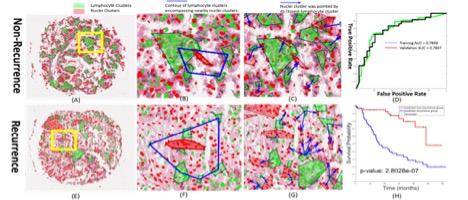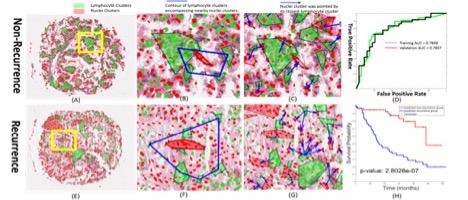
Credit: Case Western Reserve University
CLEVELAND–Researchers at Case Western Reserve University have discovered how to quickly and accurately predict which lung cancer patients will benefit from chemotherapy by analyzing how immune cells the body sends out to fight the disease are arranged.
The scientists–aided by smart-imaging computers and machine-learning methods–were able to swiftly analyze hundreds of tissue images to not only count cancer-associated immune cells–but identify patterns in how they were arranged.
That breakthrough view can now help determine which patients need chemotherapy or immunotherapy based on computational analysis of routine tissue-slide images obtained either by surgery or biopsy, said Anant Madabhushi, the F. Alex Nason Professor II of biomedical engineering at the Case School of Engineering.
"We believe we've made a critical advance to the field with this work," said Madabhushi, the lead among a dozen authors on a recent paper about the work in the journal Clinical Cancer Research. "Do you need chemo or not?–that's the direct benefit to the patient and what really matters."
While this published research focused on early-stage lung cancer tissue, further analysis also predicted the success of immunotherapy in late-stage lung cancer, Madabhushi said.
"That's why I'm super excited about this: It's a validation of what we call the 'spatial architecture' of the immune cells as predictive for the success of treatment for lung cancer," he said.
Simple tissue slides, complex cancer analysis
Oncologists and pathologists routinely take a tissue sample of cancer cells and then capture an image of that tissue. But the advent of deep-learning and machine-learning algorithms has allowed researchers to find patterns among the cells that would otherwise be nearly impossible for the human eye to detect. Most often, that means analyzing cancer cells themselves, or with limited success, counting the white blood cells–called tumor-infiltrating lymphocytes–which the body sends out to battle the cancer.
"One of the big problems is that cancer generally masks the immune response, which is why, to the body, cancer doesn't present as a foreign invader," Madabhushi said. "But it does evoke
For that reason, pathologists have been trying for the last 10 to 15 years to better understand how that immune response might correlate to how the cancer would spread or how the patient would respond to certain therapies–or whether the patient even needs the invasive and painful chemotherapy routinely give to virtually all cancer victims.
"But doing that manually is cumbersome, because there are hundreds of thousands of lymphocytes, and it's difficult to determine a pattern," Madabhushi said. "Our group has found a way to train the machine to find the lymphocytes and decipher their arrangement, their spatial architecture–and predict disease outcome."
###
Madabhushi was joined by Case Western Reserve colleagues Xiangxue Wang, Yu Zhou, and Cheng Lu from his Center for Computational Imaging and Personalized Diagnostics and Pingfu Fu from the Department of Population and Qualitative Health Sciences .
Other academic partners included: Germán Corredor and Eduardo Romero, from the National University of Colombia; Konstantinos Syrigos, from the University of Athens; David Rimm and Kurt Schalper, of the Yale University School of Medicine; pathologist Michael Yang, of University Hospitals Cleveland Medical Center; and thoracic oncologist Vamsidhar Velcheti, the Perlmutter Cancer Center at NYU Langone Medical Center.
Since 2016, Madabhushi and his team have received over $9.5 million from the National Cancer Institute to develop computational tools for analysis of digital pathology images of breast, lung and head and neck cancers to identify which patients with these diseases could be spared aggressive radiotherapy or chemotherapy.
Media Contact
Michael Scott
[email protected]
216-368-1004
@cwru
http://www.case.edu
Original Source
http://thedaily.case.edu/shaping-cancer-fight-smart-imaging-computers/





